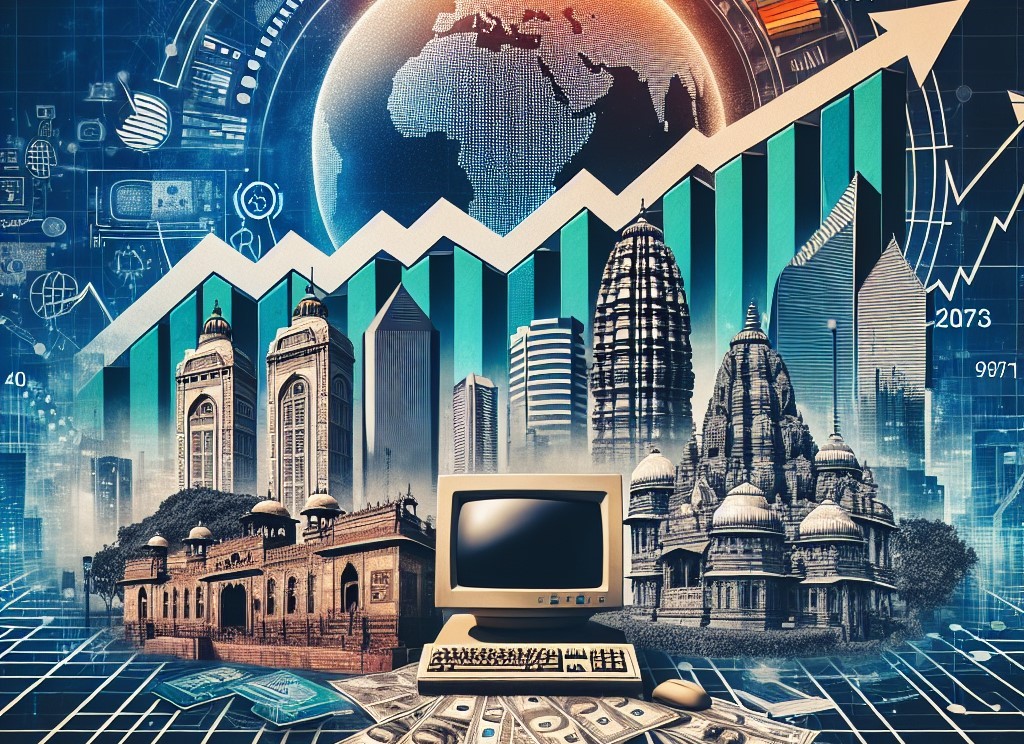India’s IT industry has come a long way since the establishment of Tata Consultancy Services (TCS) in 1974. TCS was the first of its kind, pioneering the path for what would become a booming sector. Today, the evolution of IT stands as one of the largest and fastest-growing industries in the country, significantly contributing to India’s economic growth and global reputation as a technology hub.
The early years saw major companies like TCS, Infosys, and Wipro dominate the market, primarily focusing on providing services such as software development, maintenance, and consulting to international clients. Their success not only brought in much-needed foreign investment but also helped transform India into a leading destination for technology services and outsourcing.
The government recognized the potential of this sector and introduced several initiatives to promote its development. These included tax incentives, easier regulations, and subsidies for setting up infrastructure facilities like software technology parks.
With the surge in demand for IT services, new players entered the market, offering a wider range of services and solutions. This led to increased competition and innovation within the industry, pushing companies to constantly evolve and stay ahead of the game.
These companies established robust infrastructures and created millions of jobs, leading to the development of tech cities like Bengaluru, Hyderabad, and Pune. They also set standards for quality and innovation, attracting further investment and talent from around the world.
In recent years, there has been a notable shift towards disruptive technologies, including cloud computing, artificial intelligence (AI), and the Internet of Things (IoT). Indian companies have been quick to adapt to and capitalize on these emerging trends, fostering a new wave of innovation and entrepreneurship. This adaptability has led to the growth of new players in the market, such as tech startups and specialized service providers, further diversifying the industry.
Impact of Indian Education System on IT Industry
India’s strong education system has played a significant role in the growth of its IT industry. The country produces a large pool of talented and skilled individuals, with a strong emphasis on math and science education. This has created a workforce that is well-suited for the demands of the IT sector.
Additionally, India’s academic institutions have also adapted to the changing needs of the industry by offering specialized courses in technology-related fields. This has helped bridge the gap between theoretical knowledge and practical skills, making graduates job-ready.
This abundance of skilled professionals has not only fueled the growth of domestic companies but also made Indian talent highly sought after globally. Multinational corporations have set up offices and research centers in India, taking advantage of the country’s large pool of skilled workers at a lower cost.
Moreover, many companies have established partnerships with educational institutions to provide students with hands-on experience through internships and training programs. This not only benefits students but also allows companies to identify and recruit top talent early on.
The government has also taken steps to promote the growth of IT education in India by setting up dedicated institutes and universities, such as the Indian Institutes of Technology (IITs) and Indian Institutes of Information Technology (IIITs). These institutions have produced some of the most successful leaders and entrepreneurs in the IT industry, further solidifying India’s position as a global technology powerhouse.
Growth of Indian Outsourcing Companies
One of the key factors behind India’s success in the IT industry has been its outsourcing services. Indian companies offer cost-effective solutions with high-quality deliverables, making them attractive to international clients.
The country’s vast talent pool, lower labor costs, and favorable government policies have made India a preferred destination for outsourcing IT services. Several factors have contributed to this trend:
- Cost-efficiency: The cost of operation is significantly lower in India compared to developed nations like the US and UK.
- Skilled workforce: As mentioned earlier, India produces millions of skilled graduates every year, making it easier for companies to find the right talent.
- Time zone advantage: India’s time zone allows for round-the-clock work, making it easier to meet tight deadlines and offer 24/7 customer support.
- English proficiency: India has a large English-speaking population, making communication with international clients seamless.
As a result of these factors, Indian outsourcing companies have seen tremendous growth, with many companies now ranking among the top global service providers. These companies not only provide services to established businesses but also cater to startups and small businesses looking for affordable solutions.
The top 10 IT outsourcing companies today include:
- Tata Consultancy Services (TCS): the largest IT outsourcing company in India, with over 469,000 employees and headquarters in Mumbai.
- Infosys: one of the top providers of IT services, with over 242,000 employees and offices around the world.
- Wipro: a multinational corporation with over 175,000 employees and headquarters in Bangalore.
- HCL Technologies: operates in more than 50 countries and has over 190,000 employees.
- Tech Mahindra: headquartered in Pune and employs over 131,500 people worldwide.
- Cognizant Technology Solutions: an American multinational that has a large presence in India with approximately 290,000 employees.
- L&T Infotech: a subsidiary of Larsen & Toubro, with over 33,000 employees and headquartered in Mumbai.
- Mindtree: a mid-sized company with around 21,000 employees and headquarters in Bangalore.
- Mphasis: has over 28,000 employees and offers services to clients across various industries.
- Hexaware Technologies: has more than 20,000 employees and provides IT services to companies globally.
These companies have not only contributed significantly to the growth of India’s IT industry but also propelled the country’s economic development. They have created thousands of jobs and brought in significant revenue through exports, further solidifying India’s position as a global technology leader.
Foreign Investment in India’s IT Sector
Foreign investment has been a crucial factor in the growth of India’s IT industry. It has not only provided access to capital but also opened up opportunities for collaboration and knowledge sharing. Over the years, many multinational corporations have set up their operations in India, attracted by its skilled workforce and cost-effective services.
The presence of global companies has also led to the transfer of technology and know-how, further boosting the capabilities of Indian firms. This influx of foreign investment has contributed significantly to job creation, with millions employed directly or indirectly by the IT industry.
Furthermore, the emphasis on research and development has increased, with companies investing in cutting-edge tech solutions to meet global demands. Government initiatives have also played a crucial role in supporting the IT sector, through policies and programs aimed at boosting digital infrastructure and nurturing talent.
Impact on the Indian Economy
The growth of India’s IT sector has had a profound impact on the country’s economy. It has not only diversified its sources of revenue but also helped in bridging the urban-rural divide by creating job opportunities in smaller towns and cities.
Moreover, the success of the IT industry has also spurred innovation and entrepreneurship, leading to the emergence of start-ups and a thriving ecosystem for technology-based businesses. This has further bolstered India’s position as a global leader in technology services.
The IT industry has also played a critical role in India’s balance of trade, with exports from the sector accounting for a significant portion of the country’s total exports. This has helped bring in foreign exchange and boost economic growth.
Furthermore, the impact of the IT industry is not limited to economic benefits. It has also contributed to social development through education and skill-building programs, particularly in rural areas where access to quality education may be limited.
Future Outlook
As technology continues to evolve at a rapid pace, the future looks bright for India’s IT sector. The country’s strong pool of talent, favorable government policies, and increasing focus on emerging technologies make it well-positioned to continue its growth trajectory.
The sector is expected to continue diversifying, with a greater emphasis on research and development in areas such as AI, data analytics, and cybersecurity. The Indian government has also set ambitious targets for the sector, including achieving $1 trillion in revenue by 2025 and creating an additional 3.5 million jobs.
Conclusion
In conclusion, the evolution of IT in India has been a remarkable journey, driven by local talent, foreign investment, and technological advancements. The industry continues to grow at a rapid pace, with new opportunities emerging and expanding its impact on the economy. With the government’s support and initiatives like “Digital India,” the future looks bright for India’s IT sector, and it is poised to remain a key player in the global technology landscape. Let us celebrate the success of India’s IT industry while also looking towards a promising future filled with even more advancements and achievements.
Click here for a post on issues to consider when outsourcing to India.





